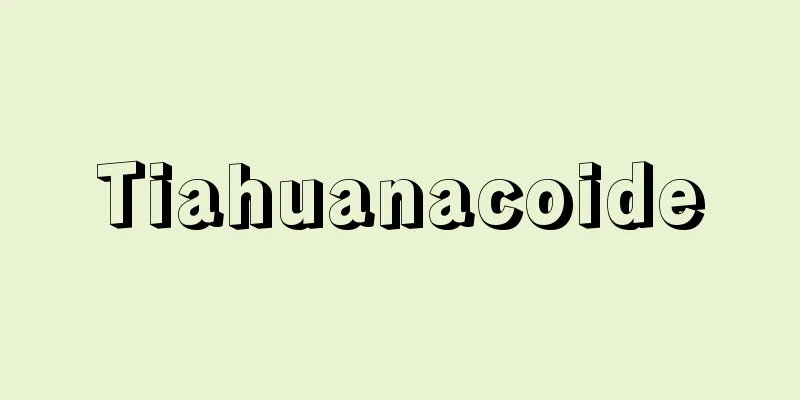Chinese - Kango

|
In Japan, it refers to Chinese-originating ideographic words (in China, it is the term used to refer to a native language in contrast to foreign languages). It is the opposite of "Japanese words" and is often differentiated from "foreign words." The issue is whether or not to recognize (1) Chinese words that were introduced into Japan before the Nara period (plum, picture, etc.), (2) foreign words that were transliterated in China (Buddha (butsu), moment (setsuna), grapes (budau), peony (botan), etc.), (3) ideographic words other than Go-on and Kan-on (futon, chair, money, etc.), and (4) Japanese-made ideographic words (fire, reply, radish, etc.) as Chinese words. In practice, (1) and (2) are excluded, and (3) and (4) are often treated as Chinese words. [Harumichi Ishizuka] HistoryKanji and Chinese words were introduced to Japan in the 1st century as currency and seals, but it is thought that they began to be used for writing and other purposes from the 5th century onwards. As many cultural artifacts were introduced from China, Chinese words began to be used as terminology, mainly by intellectuals. In the Nara period Man'yoshu, compound words with Japanese words such as "Ogaki (male hungry ghost)," "Megaki (female hungry ghost)," and "Rikijimahi (sumo wrestler dance)" were already used, showing a phenomenon of assimilation into Japanese. "Kan'on" was introduced as the basic pronunciation of kanji in the latter half of the 7th century and was later made into the correct pronunciation, but "Go'on" had already become widespread in Buddhist terminology and everyday language, and both pronunciations were used for a long time afterwards. In the Heian period, Chinese words were often used in kana literature (such as "seu-soko" (message), "kesau" (desire), "aigiyau" (loveliness), and "shaujin" (devotional dedication), and were also conjugated into Japanese predicates or made into sa-hen verbs, such as "kauzu" (lecture), "keshikibamu" (feelings), "jiyauzumeku" (to be in high spirits), "sauzok" (dressed), and "shifuneshi" (persistence), and became widespread in everyday language. Japanese-made Chinese words such as "suisan" (encouragement) and "gafugo" (time of meeting) also began to be created. During the Kamakura and Muromachi periods, Chinese words became more widespread and established as part of the Japanese vocabulary, and new Chinese words based on the "Tang (Song) pronunciation" (such as "lime" (shitsukui), "bun" (manjuu), and "bottle" (bin)) were introduced. However, most of these were used as names of things and did not become established as the sounds of individual Chinese characters. Furthermore, Japanese-made Chinese words such as "fire" (kuwaji) (hinokoto), "reply" (henge) and "radish" (ohone) came to be used more than in previous generations. During the Edo period, Chinese words became even more widespread, and class-based differentiation of Chinese words was observed, such as the use of Chinese words specific to the townspeople class (business, talent, rank, etc.). Furthermore, a large number of Chinese words were created in the early Meiji period as translations of Western studies, and many of these were borrowed from Chinese translations in English-Chinese dictionaries (angel, worship, foreigner, etc.), but many Japanese translations were also created (absolute, induction, hypothesis, etc.). Even today, we rely heavily on Chinese words to express concepts. [Harumichi Ishizuka] "Yamada Takao, 'A Study of Chinese Words in the National Language' (1940, reprinted in 1970, Hobunkan)" ▽ "Ikegami Teizo, 'Modern Japanese and Chinese Vocabulary' (included in 'Language and Folklore Essays in Commemoration of Dr. Kindaichi's 70th Birthday,' 1953, Sanseido)" ▽ "Morioka Kenji, 'The Establishment of Modern Language: Vocabulary in the Meiji Period' (1969, Meiji Shoin)" ▽ "Sakakura Atsuyoshi (ed.), 'Lecture Series on the History of the Japanese Language 3: Vocabulary History' (1971, Taishukan Shoten)" [Reference] |Source: Shogakukan Encyclopedia Nipponica About Encyclopedia Nipponica Information | Legend |
|
日本では、中国起源の字音語をさす(中国では、外国語に対して自国語の称)。「和語」に対する概念であり、「外来語」とも区別することが多い。問題は、(1)古く奈良時代より以前に入ってきた中国語(梅・絵など)、(2)中国で音訳された外国語(仏(ブツ)・刹那(セツナ)・葡萄(ブダウ)・牡丹(ボタン)など)、(3)呉(ご)音・漢音以外の字音語(蒲団(フトン)・椅子(イス)・銭(ゼニ)など)、(4)日本製の字音語(火事・返事・大根など)を漢語と認めるか否かである。実際的には、(1)(2)は除外し、(3)(4)は漢語として扱われることが多い。 [石塚晴通] 沿革漢字・漢語は、貨幣・印などとして1世紀には日本に入ってきているが、書記用などに用いられるようになったのは5世紀以降と考えられている。中国から多くの文物が伝えられるとともに、その用語として漢語が知識人を中心に用いられるようになった。奈良時代の『万葉集』には、すでに「男餓鬼(をガキ)」「女餓鬼(めガキ)」「力士舞(リキジまひ)」等の和語との熟合語も用いられ、日本語への同化現象がみられる。基礎となる漢字音としては、7世紀後半期に「漢音」が伝えられ、のちに正音とされたが、すでに仏教用語・日常語に「呉音」が普及しており、以後も長く両音が用いられた。平安時代には、仮名文学にも漢語が多く用いられ(消息(セウソコ)・懸想(ケサウ)・愛敬(アイギヤウ)・精進(シヤウジン)など)、また「講(カウ)ず」「気色(ケシキ)ばむ」「上衆(ジヤウズ)めく」「装束(サウゾ)く」「執念(シフネ)し」等のごとく、日本語の用言として活用させたり、サ変動詞をつくったりして、日常語として普及していった。また、「推参(スイサン)」「合期(ガフゴ)」等の日本製漢語もつくられるようになった。鎌倉・室町時代には、日本語の語彙(ごい)として漢語はさらに普及・定着し、新たに「唐(とう)音(宋(そう)音)」に基づく漢語(石灰(シツクイ)・饅頭(マンヂウ)・瓶(ビン)など)も入ってきたが、これらの多くは物の名として入り、一字一字の漢字の音としては定着しなかった。また、「火事(クワジ)(ひのこと)」「返事(ヘンジ)(かへりごと)」「大根(ダイコン)(おほね)」等の日本製漢語も前代以上に用いられるようになった。江戸時代には、漢語はさらに普及し、町人階級特有の漢語(商売・才覚・分限など)が用いられるなどの漢語の階級による分化もみられるに至っている。さらに、洋学の翻訳語として明治初期にかけて漢語が大量につくられ、これらのなかには英華字典の中国訳の借用も多い(天使・礼拝・異邦人など)が、日本製の訳語(絶対・帰納・仮説など)も多くつくられた。現代においても、概念を表すことばなど漢語に多くを依存している。 [石塚晴通] 『山田孝雄著『国語の中に於ける漢語の研究』(1940/再版・1970・宝文館)』▽『池上禎造著『近代日本語と漢語語彙』(『金田一博士古稀記念言語民俗論叢』所収・1953・三省堂)』▽『森岡健二著『近代語の成立明治期語彙篇』(1969・明治書院)』▽『阪倉篤義編『講座国語史3 語彙史』(1971・大修館書店)』 [参照項目] |出典 小学館 日本大百科全書(ニッポニカ)日本大百科全書(ニッポニカ)について 情報 | 凡例 |
Recommend
Karasuishi (coal) - Karasuishi
...It is currently the world's largest coal p...
Punishment - Seibai
〘noun〙① To conduct politics. To carry out governme...
Kyoto Independent Exhibition
…However, the 15th exhibition (1963) was the last...
brain vesicle
…the olfactory system is associated with the fore...
Tridacna squamosa (English spelling)
…[Tadashige Nabe]. . … *Some of the terminology t...
Manuel des Amphitryons (English)
…He grew up in a wealthy family, with his grandfa...
Swietenia mahagoni (English spelling)
… [Ken Ogata]. . … *Some of the terminology that ...
Airou - Airou
…They belong to the Tibetan, Dai, and Miao ethnic...
Ukrainian Church - Ukraine Church
The Orthodox Church of Ukraine. Formed an autonomo...
Geschwind, N. (English spelling) GeschwindN
... Regarding the difference in the functions of ...
Torn gasauraboshi - Torn gasauraboshi
In Japan, it grows on Iriomote Island, but in trop...
American chestnut
...It is difficult to cultivate in Japan because ...
Monopoly
Monopoly: a monopoly. A monopoly. Also, the right ...
Alterist - Alterist
…A brotherhood had its own altar in a particular ...
Iwayado - Iwayado
This is an old town area in the northern part of O...









